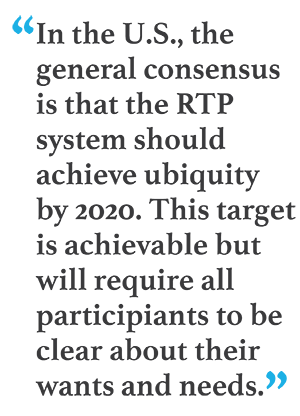
A strong payment infrastructure provides essential plumbing to carry the financial flows of businesses. For most companies, payments move via an orderly process that has followed the same slow, steady schedule for decades. But today, for the first time in 40 years, corporate treasury departments have a new option: real-time payments (RTP). Companies can now add a new pipe to their plumbing to accommodate funds transfers that move at unprecedented speeds.
The idea sounds compelling, but changing a core corporate system that's already working well can be frightening. At first sight, RTP may seem like an intimidating, costly investment that offers only amorphous benefits. Cost-conscious corporate treasury departments rarely set aside large budgets for innovation in accounts payable (A/P) and accounts receivable (A/R) systems.
The most successful RTP adoptions are those that are carefully designed to fit an organization's unique and specific needs, ultimately making their treasury teams integral to the company's strong relationships with clients and business partners. At the end of the day, a successful payment ecosystem is one that mixes and matches payment methods so that each payment utilizes the settlement method that is best for both the buyer and the seller.
Improvements to Cash Flows
Through real-time payments, corporate treasury departments can make disbursements or payments to customers and business partners around the clock, sending requests and receiving instant confirmations of the transaction. While the name “RTP” focuses attention on the speed of funds settlement, real-time payments' larger benefit can be found in the information that travels with each payment.
RTP enables senders and receivers to have more detailed conversations about each payment. That's because both counterparties to a transaction have an array of standardized message types at their disposal. These are built into the RTP messaging standard to handle common scenarios in the lifecycle of a transaction. They facilitate communication when a transaction completes successfully, as well as enabling the counterparties to communicate about exceptions. For example, a company responding to a payment request from a supplier can either accept the request in its entirety or select only certain line items that it agrees to pay for and immediately communicate that information to the supplier. It can also indicate that an invoice number is not found, or that an invoice amount is not correct. A recipient of a payment can indicate that the amount received is incorrect and request reconciliation.
Because these exchanges are happening directly within the payment system, the communications do not require individuals to switch into an email system to compose a free-form email or interrupt their workflow with a phone call or fax. RTP's messaging and automation capabilities take ad hoc, unstructured follow-up out of the equation.
 Instant communications among corporate counterparties around requests for payment, approvals or rejections, and payment confirmations produce value up and down the company's customer and supplier networks. Both the speed and granularity of communications in RTP messaging can accelerate resolution of exceptions. Moreover, the detailed payment messages simplify account reconciliation and help companies develop an accurate snapshot of their current and upcoming cash positions. When treasuries trade float for visibility, they enable business to be conducted with far more certainty.
Instant communications among corporate counterparties around requests for payment, approvals or rejections, and payment confirmations produce value up and down the company's customer and supplier networks. Both the speed and granularity of communications in RTP messaging can accelerate resolution of exceptions. Moreover, the detailed payment messages simplify account reconciliation and help companies develop an accurate snapshot of their current and upcoming cash positions. When treasuries trade float for visibility, they enable business to be conducted with far more certainty.
In fact, as the settlement process comes close to real-time, the payments themselves become a conversation. Suddenly, corporate treasury departments are provided with the rare chance to interact with customers, wholesalers, suppliers, vendors, service providers, and other trading partners, 24×7. The consumer-services sector is a prime example of an industry that stands to gain from RTP in this way. Consumers are already used to interacting with businesses at all hours of the day and night. With RTP, an insurance company may be able to provide more timely support, sending disaster relief disbursements on weekends if that's when their clients most need assistance. Likewise, a utilities company can process customers' payments after regular office hours, when customers feel most comfortable taking care of personal matters.
Where RTP Fits in the Payment Landscape
Obviously, a company can achieve these benefits only after both it and its trading partners adopt RTP technologies. And large-scale evolution of the U.S. payment infrastructure cannot be achieved through participation of a few. Rather, it requires banks and businesses to work together to make real-time payments ubiquitous throughout the financial services industry. Only at the point of widespread uptake of real-time payments, through industrywide collaboration, will this innovation be a success.
Although RTP has the potential to bring revolutionary change, we expect the Automated Clearing House (ACH) payment network to also continue developing. When RTP is ubiquitous, it will overcome the limitations of ACH cut-off times; companies will no longer have to wait for their banks to accumulate transactions received throughout the day, to process them all simultaneously in one batch. However, same-day ACH or next-day ACH may still be the best payment option for many transactions. ACH still offers a decided cost advantage over RTP in use cases that meet four criteria: First, the payer and payee are well-known to each other; second, the payment and amount are known in advance and can be scheduled; third, the payment is recurring; and fourth, there is little likelihood that the payment might need to be revoked. In these scenarios, ACH remains a proven solution. It is unreasonable to imagine that transactions such as payments to salaried employees or long-standing suppliers would migrate to RTP.
Nevertheless, the advantages of RTP may trump cost concerns in situations where a company needs the ability to initiate requests 24×7. RTP also has the edge when the finality of the payment matters—such as when the company needs to request funds from a delinquent customer in order to restore service, or request payment from a new customer who might revoke payment after the goods have been shipped.
- Related: Real-Time Payments Have Arrived
Eventually, companies deciding how to allocate payments among ACH, RTP, and other payment methods will have to identify the most effective approach for each type of transaction that they make. Then they will have to work with their counterparties to define the parameters for each payment method. The general rule of thumb is the more that speed and finality matter, the greater the business case for RTP.
Having another option in the corporate payment portfolio facilitates a new way of interacting with clients and customers. Businesses can meet customers' needs more precisely by leveraging the best available payment option. That is why we foresee the ACH network, the incumbent payment system of choice, living a long, happy life alongside RTP.
Prepare Now for RTP
RTP has the potential to be transformative for corporates by creating better opportunities for client interaction, but the adoption of RTP is a step-by-step process that treasury departments and banks must undertake together. This process must always begin with a deep understanding of the unique needs and characteristics of each company's payment system. Businesses considering implementing RTP need to begin by considering what their current systems look like, what their needs are, and which payment methods can best accommodate each of those needs. RTP is one of several payment methods that will all need to be woven into consolidated A/P and A/R systems.
Some companies see these discussions as an opportunity to re-evaluate the entirety of their end-to-end systems. They invest in technology upgrades in order to fully integrate RTP into their ERP system and develop back-end functionality to support the rich data around their transactions. More often, they look for the most cost-efficient way to integrate RTP into their existing systems and processes, because a typical treasury department does not have the resources or budget to undertake a fundamental transformation from the ground up.
One of the largest shifts with RTP is the movement from a world of batch processing to a world of regular flow of messaging over application programming interfaces, or APIs. Many older treasury management systems are designed on the model of periodic transmittal of information in batches, and so are the ERP and other business systems with which they exchange information. Those systems will continue to exist in parallel, just as RTP will exist in parallel with other payment rails. This coexistence presents numerous technical design challenges that require close partnership with IT to resolve.
In addition, moving from batch mode to batch-plus-API mode requires changes to underlying business processes and employee behaviors. The path to adoption must include robust and intentional change management efforts. It also likely calls for re-engineering many processes such as order-to-cash and supply chain processes that historically resulted only in periodic batches of transactions at a few points in the business day. Customer relationship management (CRM), demand chain, and fulfillment might also benefit from RTP-related process improvements.
Companies with international operations may have a different view of the path to adoption, if they are operating in markets where instant payments have been in place longer. They can already look to best practices and existing experience working with local correspondent banking partners as a way to leverage both technical and operational expertise. For the time being, they will have to leverage each of these networks and systems individually and work with their bank partners to find the best solutions to get payments into local clearing channels, but that experience can offer repeatable models for RTP in the United States.
Multinationals also provide the footprint for what will be the next stage of evolution for the industries and payment networks around the world: global real-time payments. As global standards emerge and networks begin to fit together, banks will increasingly offer more cross-border payment solutions to match their corporate clients' geographical footprints.
In the U.S., the general consensus is that the RTP payment system should achieve ubiquity by 2020. Although ambitious, this target is achievable—but it will require all participants to be clear about their wants and needs. The payment network is only as powerful as the combined experiences of the banks and corporate treasury departments that are using it, and that are providing one another with constant guidance and feedback. The more collaboration there is, the better the payment ecosystem will work, both domestically and globally.
For businesses, the transition to using RTP is not easy. But when RTP reaches critical mass within the business community, we expect it to bring substantial improvements to treasury and payments systems. We envision a future where corporate treasury departments are leading the conversation on customer interaction and where consumer insights about preferences, satisfaction, profitability, and payment performance are mined from the newly tapped streams of payments information. With today's thirst for innovation and growth, we believe this journey is hugely promising, bringing this area of financial services back to the future.
 Michael Bellacosa is a managing director at BNY Mellon and head of the bank's Global Payments Product Management Group. He is responsible for global wire clearing, multicurrency, FX, ACH, and real-time payment services. He is based in New York and has over 20 years of payment experience in product and operations management.
Michael Bellacosa is a managing director at BNY Mellon and head of the bank's Global Payments Product Management Group. He is responsible for global wire clearing, multicurrency, FX, ACH, and real-time payment services. He is based in New York and has over 20 years of payment experience in product and operations management.
 Carl Slabicki is a director and product line manager at BNY Mellon for immediate payments. In his current role, Slabicki is responsible for strategy and development of new faster payment solutions such as The Clearing House's real-time payments and Tokenized Payments® now available with Zelle®.
Carl Slabicki is a director and product line manager at BNY Mellon for immediate payments. In his current role, Slabicki is responsible for strategy and development of new faster payment solutions such as The Clearing House's real-time payments and Tokenized Payments® now available with Zelle®.
BNY Mellon originated the first transaction to go out over the RTP network on November 13, 2017.
© Touchpoint Markets, All Rights Reserved. Request academic re-use from www.copyright.com. All other uses, submit a request to [email protected]. For more inforrmation visit Asset & Logo Licensing.



